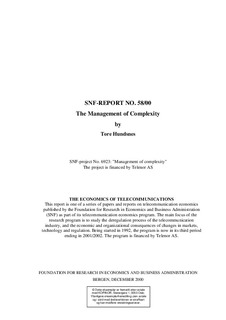| dc.description.abstract | The complex structure of many business environments, and indeed many corporations or organizations operating in them, implies great challenges for managers. What sources generate this complexity, and how can it be managed? Chaos theory and complexity theory represents new perspectives on how to understand the dynamics and behavior of complex adaptive systems, and why it is difficult to predict their future state. These systems create, or inhibit several sources of complexity for managers. Several mechanisms, among them self-organization and strategic options, are suggested to manage the complexity in organizations as complex adaptive systems. The properties of these systems, the sources of complexity, and the mechanisms to manage complexity have important implications for managers. This report represents the first of three phases in a research project on complexity in organizations. The findings discussed here will be investigated more thoroughly through empirical research. The second phase will focus on specific cases within Telenor and study mechanisms applied under different forms of complexity. These different mechanisms will be analyzed according to their impact on performance such as innovation and efficiency. | en |
